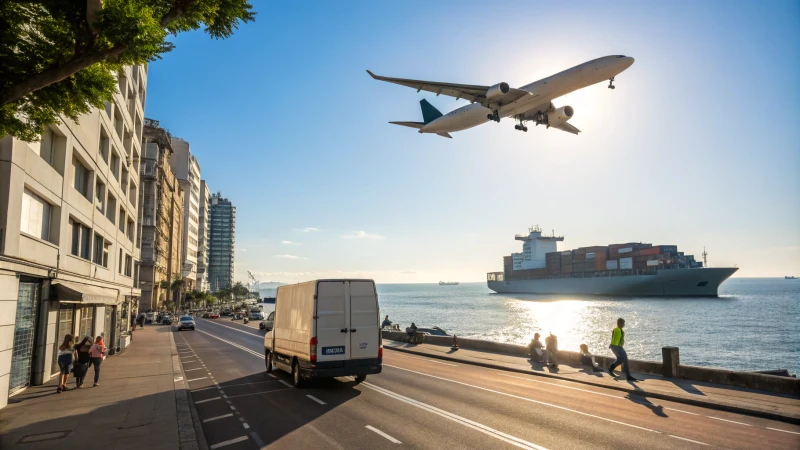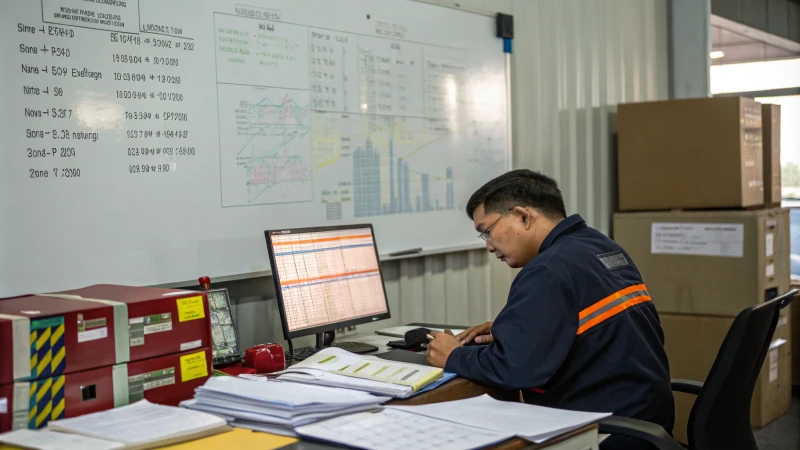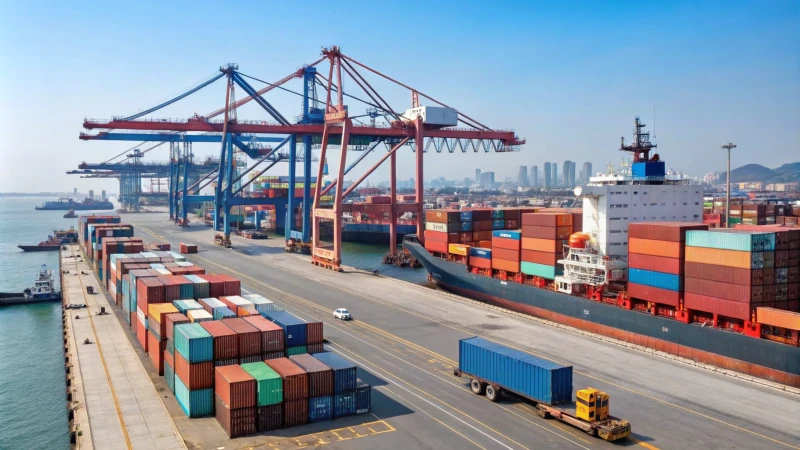Navigating the maze of shipping costs from China to Australia feels like a rite of passage for anyone in the import business.
Shipping from China to Australia costs can vary widely. Air freight typically ranges from $3.5 to $7 per kilogram, while express services like DHL and FedEx cost between $20 and $40 per kilogram. For budget-friendly options, sea freight is ideal, with a 20-foot container priced between $1,600 and $2,000.
When I first started importing electronics, I was overwhelmed by the dizzying array of shipping choices and costs. It felt like I was juggling numbers constantly, trying to find the sweet spot between cost-effectiveness and timely delivery. Whether you're a seasoned importer like me or just starting, understanding these nuances can save you a lot of headaches—and money. So let's delve into each shipping method, ensuring you choose the best fit for your needs and budget.
Air freight costs $3.5 to $7 per kg from China to Australia.True
Air freight is priced between $3.5 and $7 per kilogram.
Express services cost less than sea freight for shipping.False
Express services are more expensive, at $20-$40 per kg.
What Are the Cost Differences Between Air and Sea Freight?
Choosing between air and sea freight is like picking between speed and savings—both crucial but not always compatible.
Air freight typically costs more than sea freight, with rates ranging from $3.5 to $7 per kilogram. Sea freight is more budget-friendly, especially for large shipments, costing as little as $30 per cubic meter.
When it comes to moving goods across oceans, I've often found myself at a crossroads, pondering whether to opt for the speed of air freight or the cost-effectiveness of sea freight. It's a decision that involves weighing urgency against expense, much like choosing between taking a quick flight or a leisurely cruise.
Air Freight Costs: Speed vs. Expense
Air freight is the go-to for those moments when time is of the essence. I remember a time when I needed to get a batch of consumer electronics out to retailers in record time—air freight was my savior. However, this speed doesn't come cheap.
| Service | Cost (per kg) |
|---|---|
| Standard | $3.5 - $7 |
| Express | $20 - $40 |
Standard rates range from $3.5 to $7 per kilogram, depending on factors like the carrier and the weight of the goods. If you need even faster delivery, express services such as DHL1, FedEx, and UPS can get your packages there in a flash but at a higher cost—typically between $20 and $40 per kilogram.
Despite the hefty price tag, there's something comforting about knowing your goods are whizzing through the sky, destined to meet tight deadlines and pressing demands.
Sea Freight Costs: Economical for Bulk Shipping
On the other hand, when I'm not racing against time, sea freight becomes my best friend. It’s particularly suited for bulk shipments that aren’t in a hurry.
| Container Type | Cost |
|---|---|
| 20-foot | $1,600 - $2,000 |
| 40-foot | $3,200 - $3,800 |
| LCL | $30 - $60 per cubic meter |
Renting an entire container can be remarkably economical—$1,600 to $2,000 for a 20-foot container or $3,200 to $3,800 for a 40-foot one. For smaller loads, Less than Container Load (LCL) services are available, costing about $30 to $60 per cubic meter.
Sure, it takes longer for your goods to navigate the waves but the savings2 can be substantial—a trade-off that often pays off when dealing with large-scale shipments.
Considerations Beyond Cost
Deciding which freight option suits your needs isn't just about dollars and cents. It's also about aligning the nature of your goods with their journey's demands. High-value or perishable items often necessitate the speed3 of air freight. In contrast, bulky commodities or non-urgent deliveries fit well with sea freight's slower pace.
Ultimately, it's all about finding that sweet spot where speed meets cost-efficiency—a balance that can transform your logistics strategy into a well-oiled machine.
Air freight is cheaper than sea freight for bulk goods.False
Air freight is generally more expensive than sea freight for bulk shipments.
Sea freight costs $30 to $60 per cubic meter for LCL.True
LCL services in sea freight cost approximately $30 to $60 per cubic meter.
Why Should You Choose Express Shipping Services?
Ever wondered why express shipping has become a game-changer in the fast-paced world of logistics?
Express shipping services offer speed, reliability, and enhanced tracking, ensuring swift delivery of goods while boosting customer satisfaction and reducing damage risks, making them ideal for urgent and valuable shipments.

Speedy Deliveries for Urgent Needs
I remember the time I urgently needed a shipment of electronics from China just before the holiday rush. With express shipping, I was able to restock in record time, saving the day for my customers who depend on timely product availability. Companies like FedEx and DHL offer same-day or next-day delivery, which is a lifesaver when every minute counts.
Enhanced Reliability and Tracking
The peace of mind that comes with real-time tracking is priceless. I often find myself checking the status of my shipments multiple times a day, and express services offer advanced systems that keep me updated with every movement. This not only helps me manage my inventory better but also allows me to keep my customers informed, building trust and reliability.
With real-time updates4, businesses can manage inventory better and improve customer communication.
Improved Customer Satisfaction
There's nothing quite like the joy of exceeding customer expectations. By offering express shipping, I've noticed a significant boost in customer satisfaction. People love getting their orders faster, especially when it involves high-value or urgent items. This has not only led to repeat business but also garnered rave reviews that help my business stand out.
| Standard Shipping | Express Shipping |
|---|---|
| 5-10 Business Days | 1-3 Business Days |
| Basic Tracking | Advanced Tracking |
| Lower Cost | Higher Cost |
Reduced Risk of Damage
One of my biggest worries is the potential damage to goods during transit. Express shipping means less time on the road, and packages are handled with extra care due to their higher cost. This added protection is crucial for fragile or expensive items, giving me one less thing to worry about.
Faster shipping means less time in transit, which reduces the risk of damage to goods. Express services often handle packages with more care due to their higher cost, offering additional protection for valuable shipments5.
Competitive Advantage
Offering express shipping has given me a competitive edge in the market. It shows my commitment to customer service and attracts more customers who value quick and reliable delivery. It's a strategic move that sets me apart from competitors who stick to standard shipping options.
For businesses, providing express shipping options can set you apart from competitors who only offer standard shipping.
Cost Considerations
While express shipping can be pricier, the benefits often outweigh the costs, especially for urgent or high-value shipments. I've found that assessing the potential increase in sales against the additional fees helps determine its cost-effectiveness. It's all about weighing the immediate expenses against long-term gains.
Calculating the cost-effectiveness6 of express shipping involves assessing the potential increase in sales against the additional shipping fees.
Express shipping always guarantees next-day delivery.False
While often available, next-day delivery is not guaranteed for all shipments.
Express shipping reduces the risk of package damage.True
Less time in transit and careful handling reduce the risk of damage.
How Can I Optimize My Shipping Costs from China?
Ever looked at your shipping bill from China and thought, "There must be a way to cut these costs?" I’ve been there, and I’ve discovered some strategies that really work.
To optimize shipping costs from China, consolidate shipments, choose the right freight method, negotiate with carriers, and use digital platforms for competitive rates.

Understand Different Shipping Options
Navigating the maze of shipping options can feel daunting. I remember my first big shipment—thinking air freight was my only option, only to learn the hard way that sea freight could've saved me a fortune. Air freight is quick, but it can eat into your budget faster than you think. For those larger volumes, consider Full Container Load7 (FCL) or Less than Container Load (LCL), which are often more wallet-friendly choices.
| Shipping Method | Cost Range |
|---|---|
| Air Freight | $3.5-$7/kg |
| Express Shipping | $20-$40/kg |
| FCL | $1,600-$3,800 |
| LCL | $30-$60/cubic meter |
Consolidate Shipments
I once had this lightbulb moment when I realized that consolidating shipments could trim down my costs significantly. Think of it like carpooling for your goods; more stuff in one go means less cost per unit. Partnering with a solid freight forwarder, like Gofreighter8, can make this process smooth and efficient.
Negotiate with Carriers
Building a good rapport with carriers has been a game-changer for me. Early on, I learned that discussing my volume forecasts and seeking discounts can lead to substantial savings. Don't just settle for the first quote—shop around. Platforms like Freightos9 have been invaluable for me to compare rates swiftly.
Leverage Technology
Harnessing technology was another pivotal lesson. Digital freight platforms offer real-time data on shipping rates and routes, making it easier to spot those hidden, cost-effective routes.
Plan and Book in Advance
I’ve learned the value of planning ahead—especially during peak seasons when everyone’s scrambling for space. Booking early can often mean better pricing and less stress.
Use Tariff-Free Options
It pays to stay informed about tariff-free options or agreements between China and your country. They can shave off a good chunk of your shipping expenses. I regularly consult with a logistics expert10 to keep abreast of any changes.
These strategies have helped me keep my shipping costs manageable while ensuring smooth operations. Partnering with experienced freight forwarders is key to making these tactics work for you. Trust me, once you get the hang of it, you'll wonder how you ever managed without them!
Air freight is cheaper than sea freight.False
Air freight is faster but more expensive than sea freight.
Consolidating shipments reduces cost per unit.True
Combining smaller shipments into a larger one lowers costs per unit.
What Factors Affect Shipping Prices for Goods from China?
Shipping goods from China can feel like solving a complex puzzle, with many pieces influencing the cost. From choosing the right transport to dodging holiday surcharges, each decision matters.
Shipping prices from China are shaped by transportation modes, fuel costs, cargo type, and seasonal demand. By grasping these factors, businesses can refine their shipping strategies and save on costs.

Let me take you through my journey of navigating shipping costs from China. Each decision feels like a game of chess—strategizing to get the best value without compromising speed or safety.
Transportation Methods
The mode of transportation is a primary factor affecting shipping costs. Air freight11 is faster but more expensive than sea freight. Air costs range from $3.5 to $7 per kilogram, while sea freight is typically cheaper but slower.
| Mode | Cost Range per kg | Speed |
|---|---|---|
| Air | $3.5 - $7 | Fast |
| Sea | Variable | Slow |
Exploring different transportation methods12 helps identify cost-effective options based on urgency.
Fuel Costs
Fuel prices significantly impact shipping costs. As fuel prices rise, carriers often increase rates to cover expenses. Tracking global fuel price trends13 can provide insights into potential cost changes.
Cargo Type and Size
The type and size of cargo influence costs due to varying handling requirements. Fragile or hazardous items require special care, incurring additional fees. Full Container Load (FCL) versus Less than Container Load (LCL) also affects pricing:
- FCL: Costs range from $1,600 to $3,800 depending on container size.
- LCL: Charges approximately $30 to $60 per cubic meter.
For more precise calculations, consider utilizing a cargo cost calculator14.
Seasonal Demand Fluctuations
High demand seasons, such as holidays, often lead to increased shipping prices due to limited carrier availability. It's crucial to plan shipments around these periods to avoid peak pricing. Exploring historical shipping demand data15 can help anticipate cost spikes.
Understanding these factors has been crucial for me—and I believe it can help others too—to navigate the maze of shipping from China, ensuring efficiency and cost-effectiveness in every shipment.
Air freight is cheaper than sea freight.False
Air freight is generally more expensive than sea freight.
Fuel price increases raise shipping costs.True
Higher fuel prices lead carriers to increase shipping rates.
Conclusion
Shipping costs from China to Australia vary: air freight ranges from $3.5-$7/kg, express services cost $20-$40/kg, while sea freight for a 20-foot container is $1,600-$2,000.
-
Explore detailed DHL express rates to assess cost implications for urgent shipments. ↩
-
Discover how choosing sea freight can offer substantial savings for bulk shipping needs. ↩
-
Learn how air freight excels in delivering time-sensitive goods quickly and reliably. ↩
-
Learn about the advantages of real-time tracking in enhancing customer satisfaction and operational efficiency. ↩
-
Understand how express shipping offers extra protection for fragile and high-value items. ↩
-
Evaluate whether the benefits of express shipping justify its higher costs for your business. ↩
-
Understanding the benefits of FCL can help you decide if it's the right option for your shipping needs, potentially saving costs on large shipments. ↩
-
Explore Gofreighter's services for efficient shipment consolidation, which can help lower your shipping expenses by reducing the cost per unit. ↩
-
Freightos allows you to quickly compare shipping rates from various carriers, helping you secure the most competitive prices available. ↩
-
Consulting with a logistics expert can provide personalized advice on tariff-free shipping options and regulations that could reduce costs. ↩
-
Explore this link for detailed insights into air freight rates, helping you make informed choices when speed is a priority. ↩
-
This resource compares the costs and benefits of air versus sea freight, aiding in strategic decision-making. ↩
-
Stay updated with global fuel price trends impacting shipping costs, enabling proactive budget adjustments. ↩
-
Utilize a cargo cost calculator for precise shipping estimates tailored to your specific cargo dimensions and type. ↩
-
Understand historical demand patterns to better plan your shipments and avoid costly peak season rates. ↩




